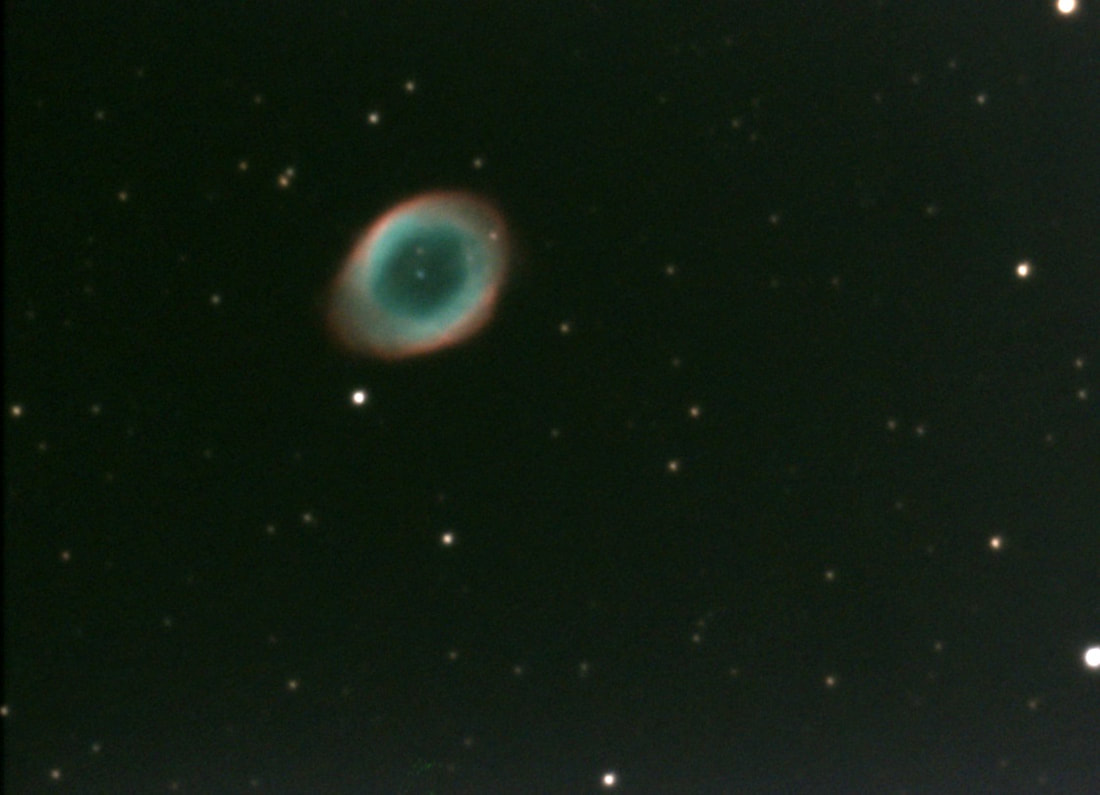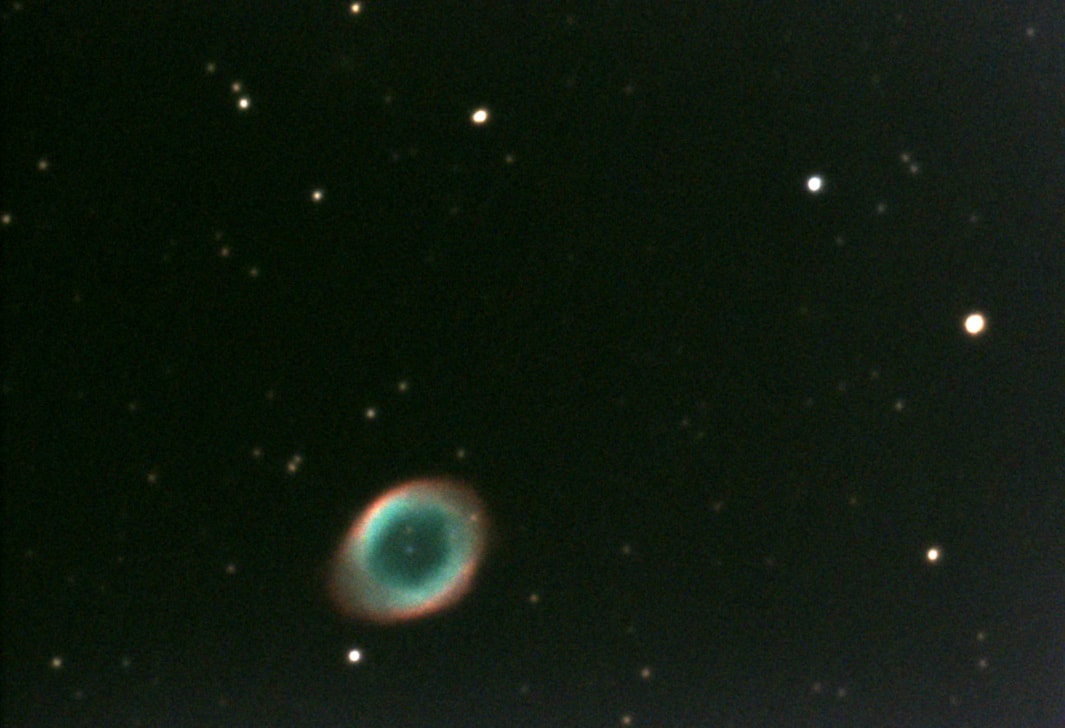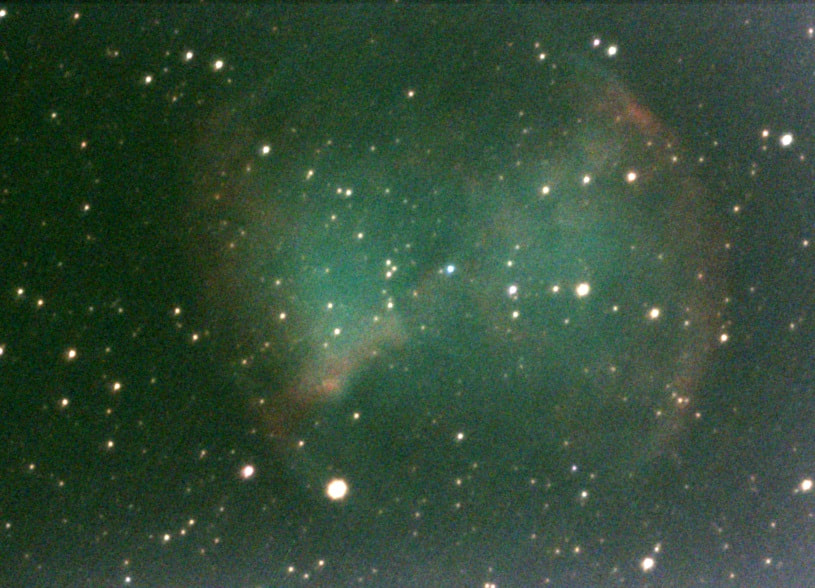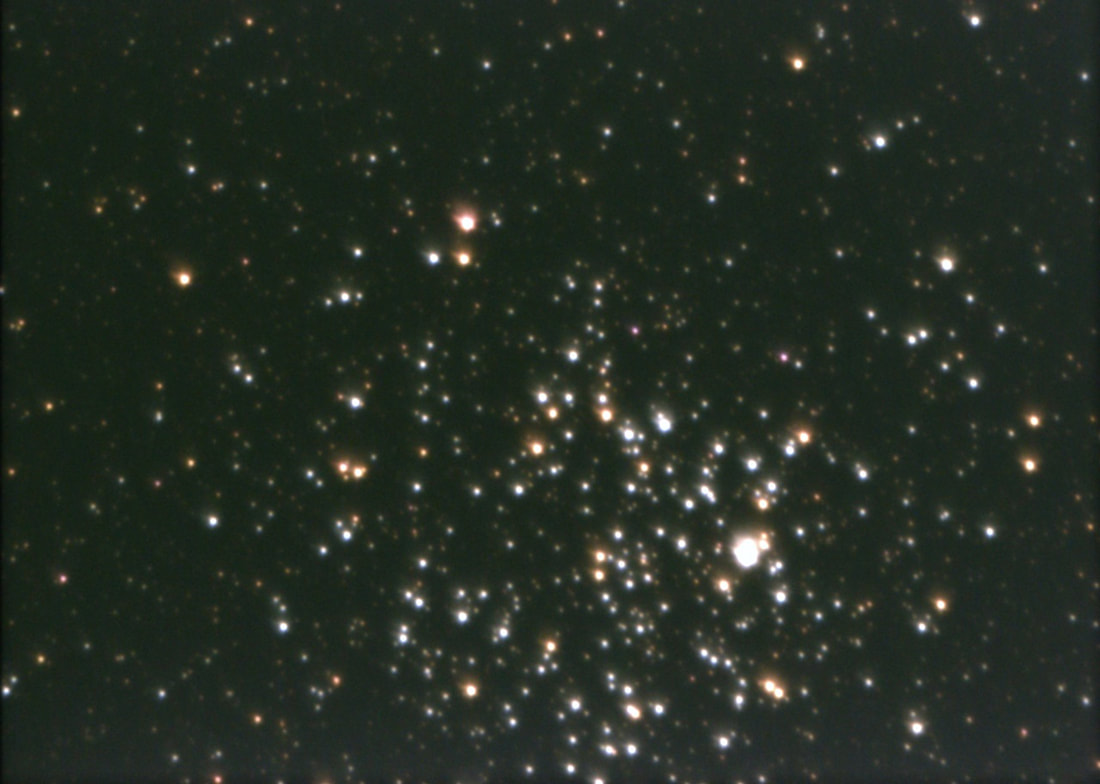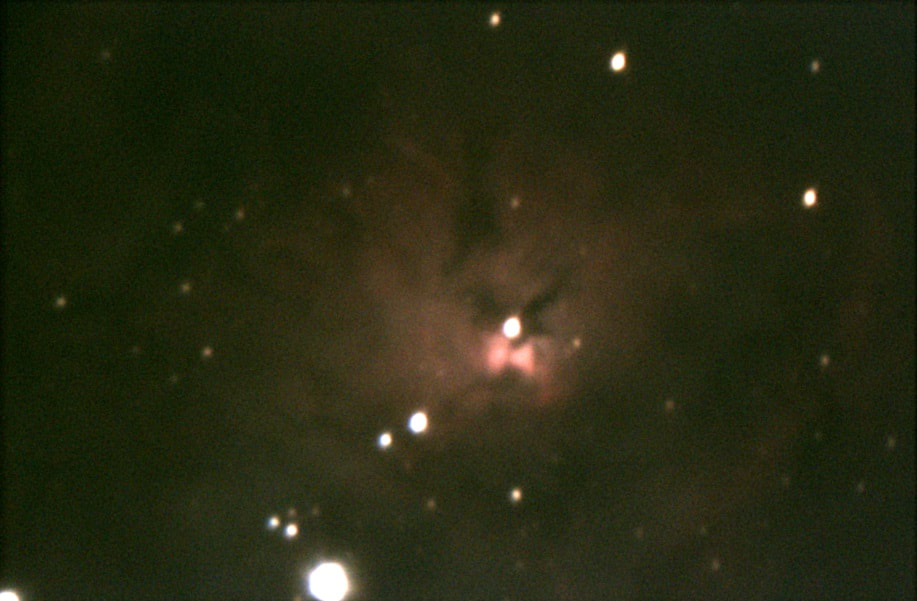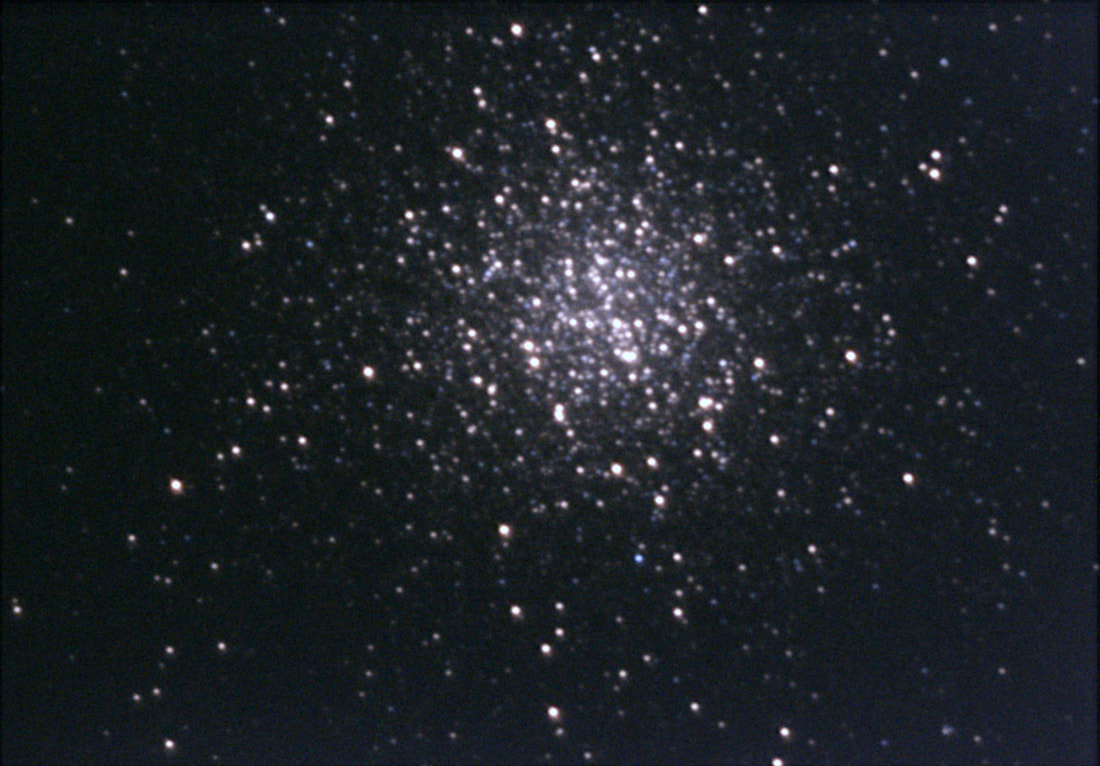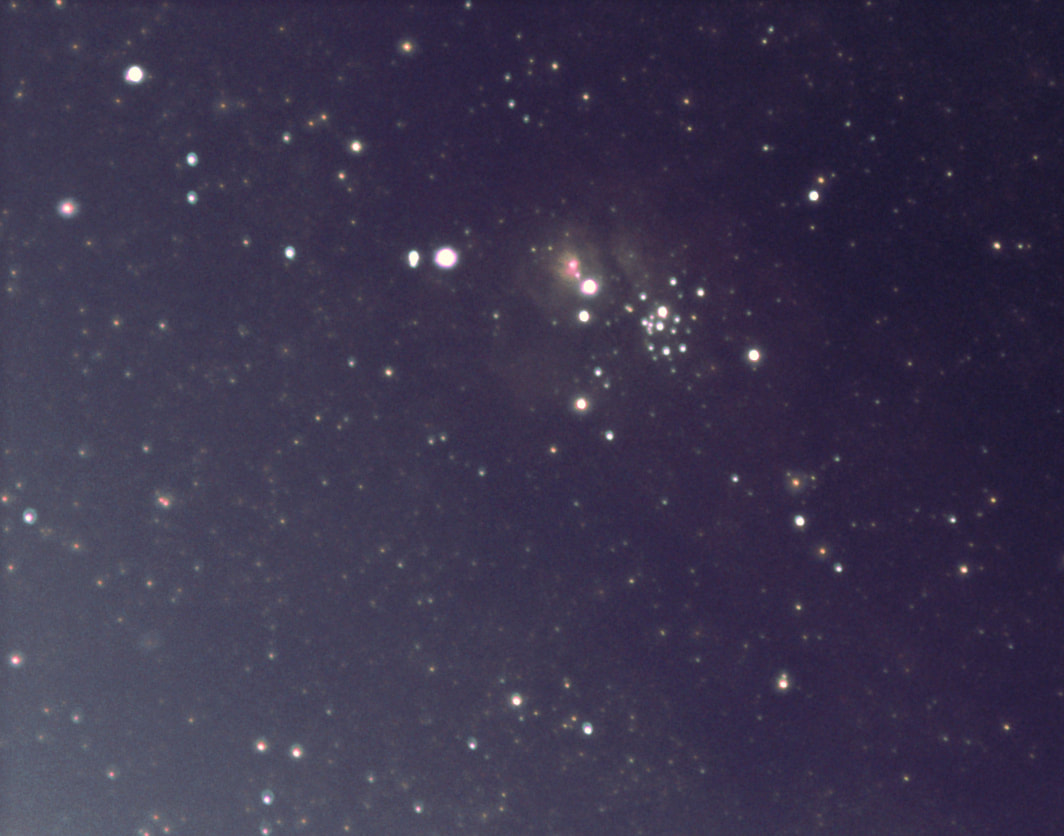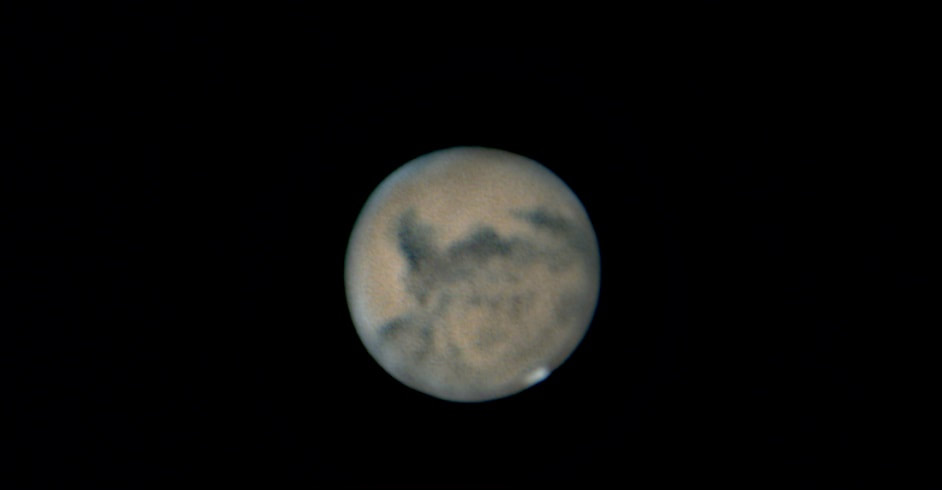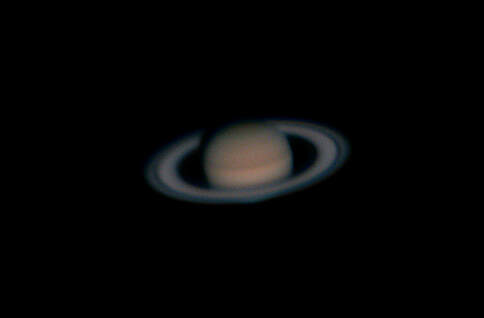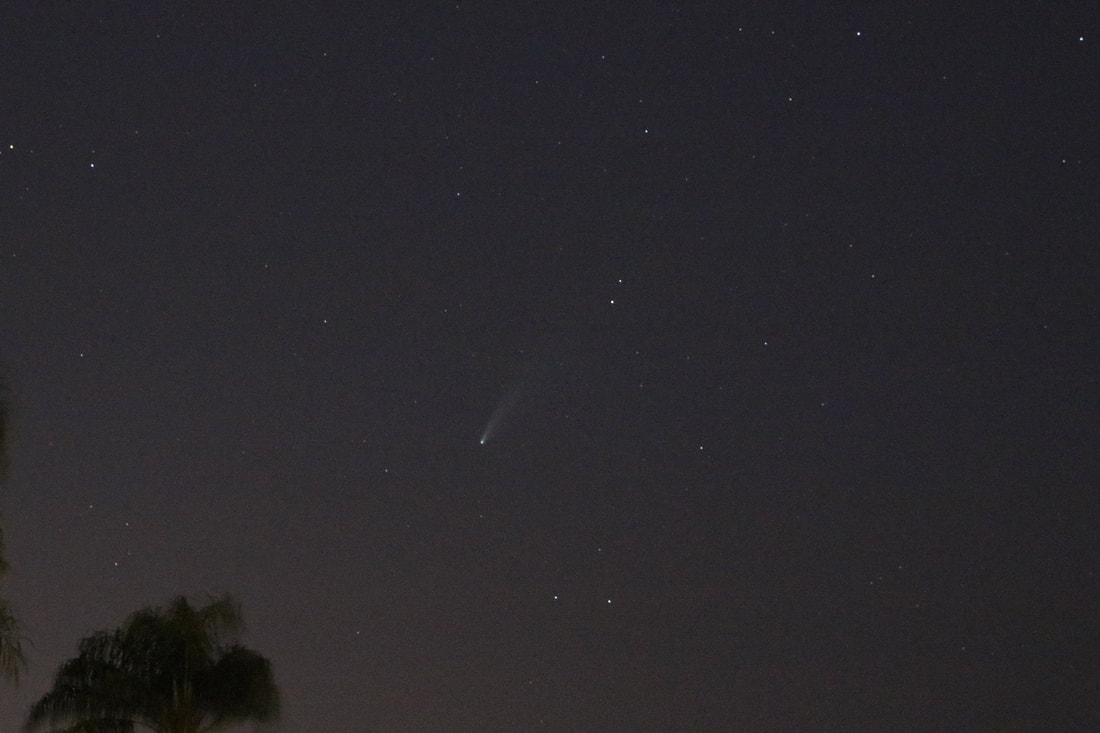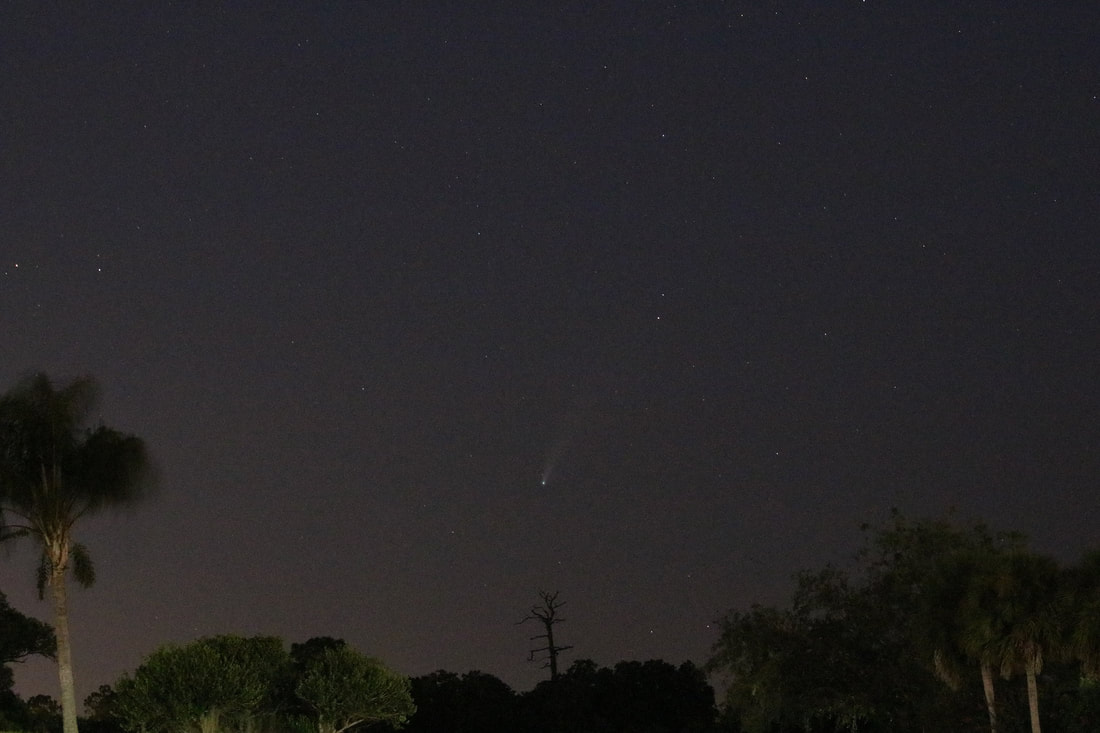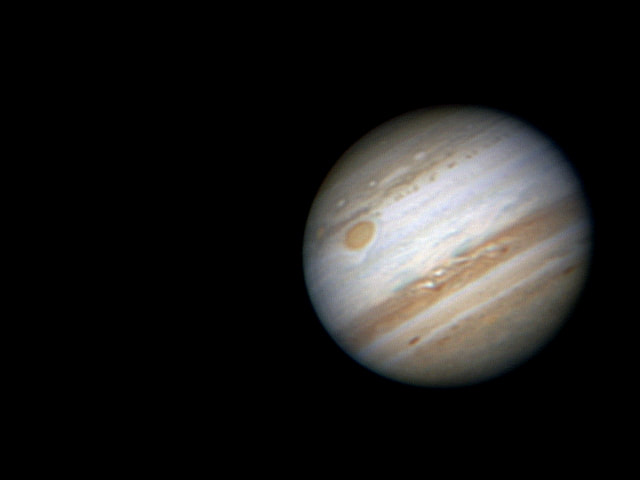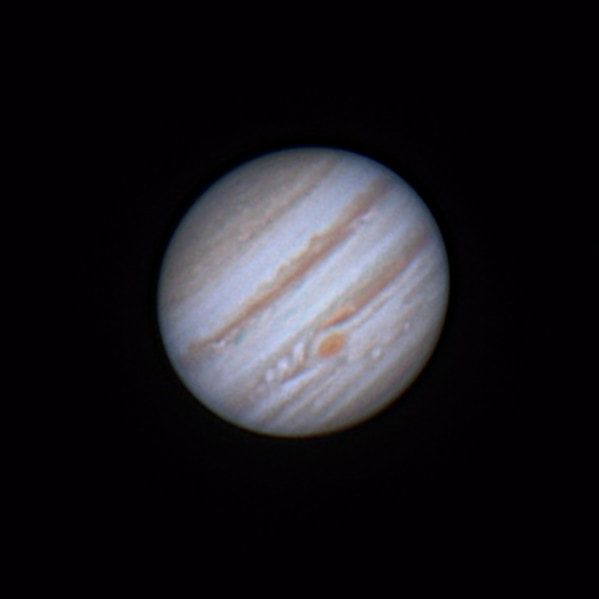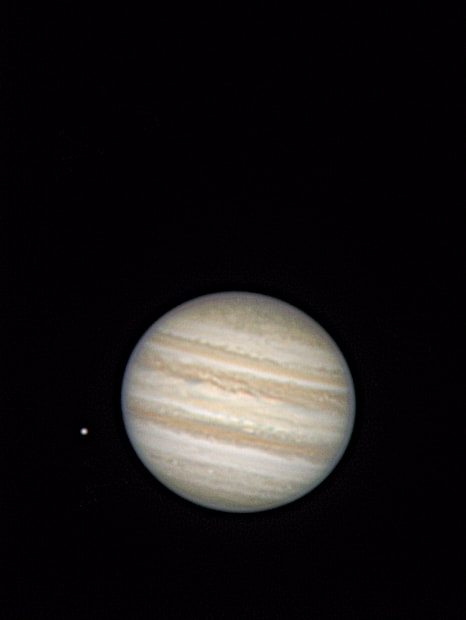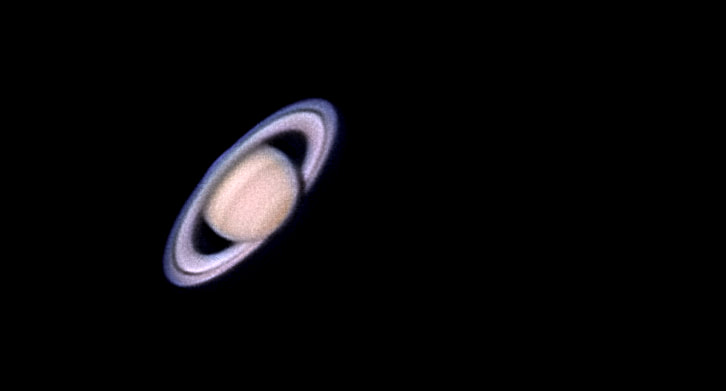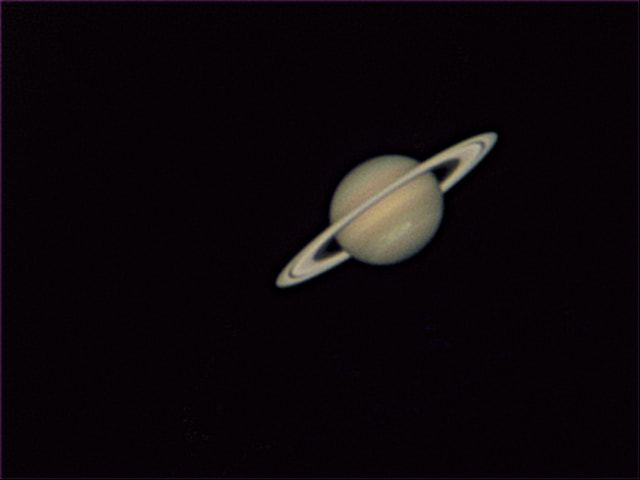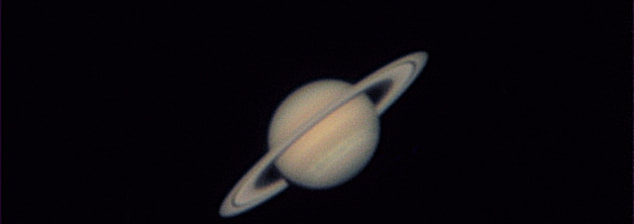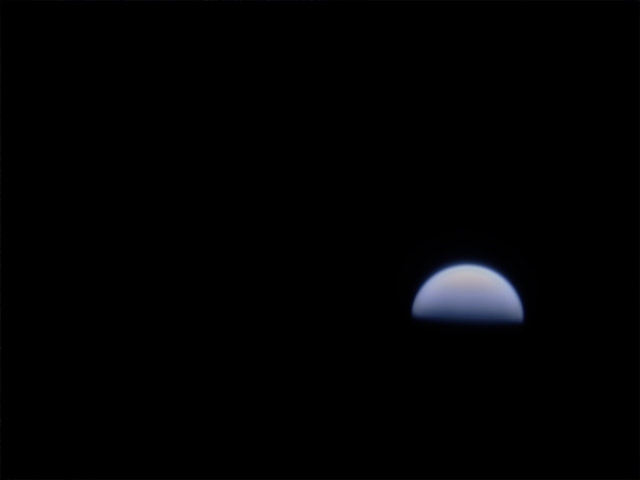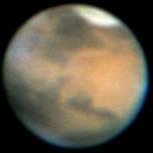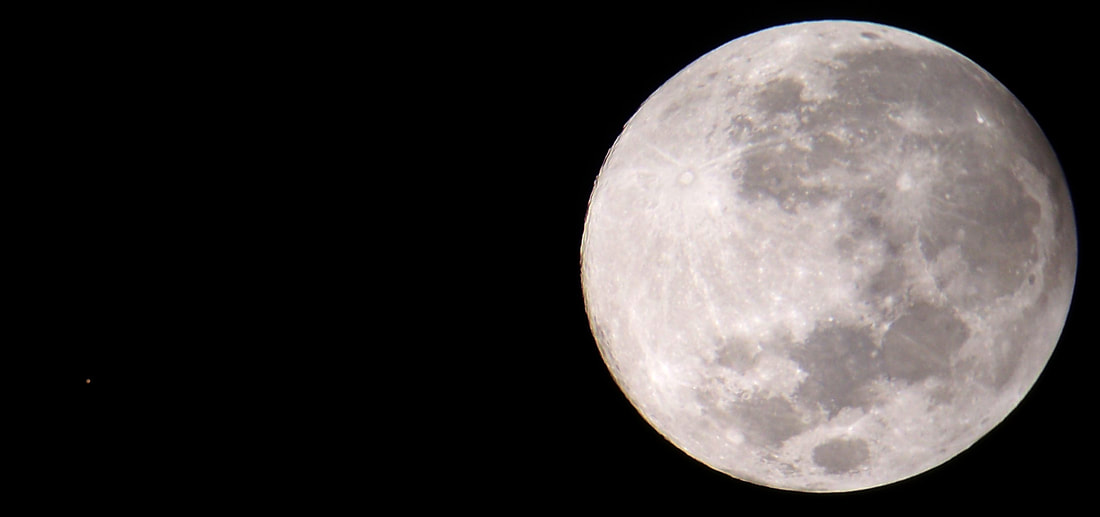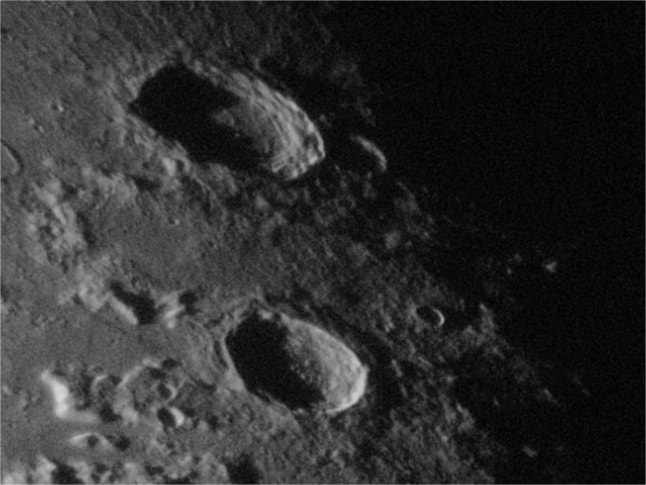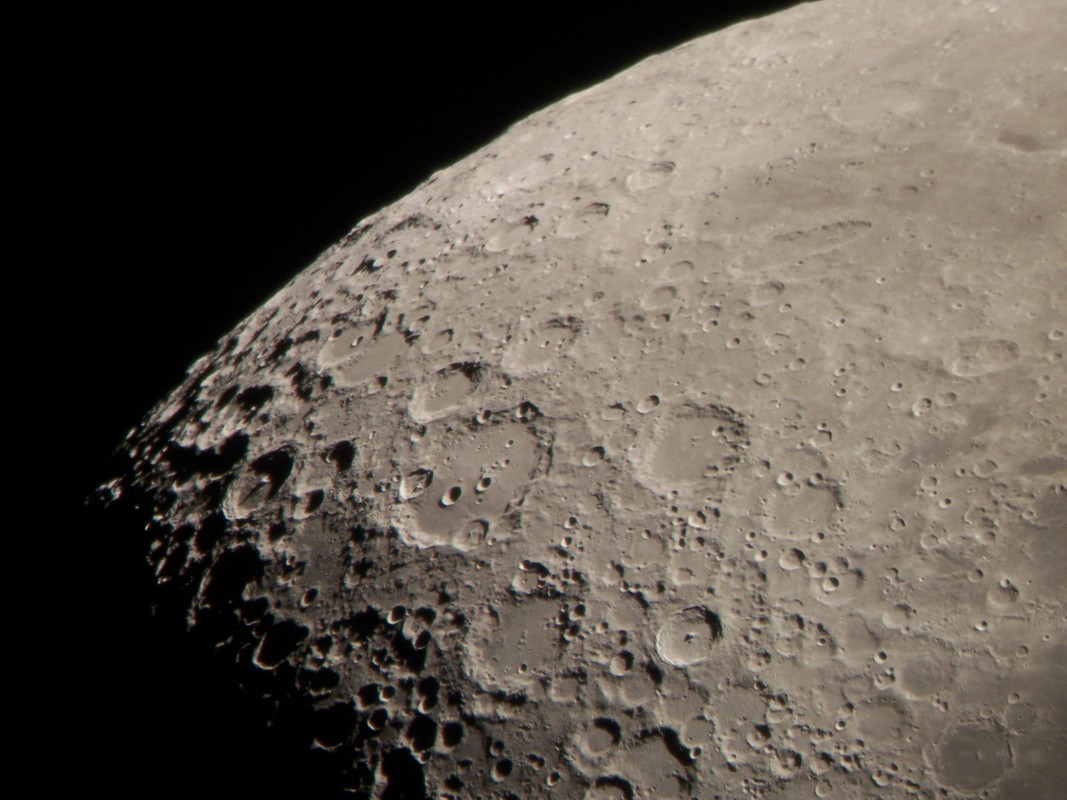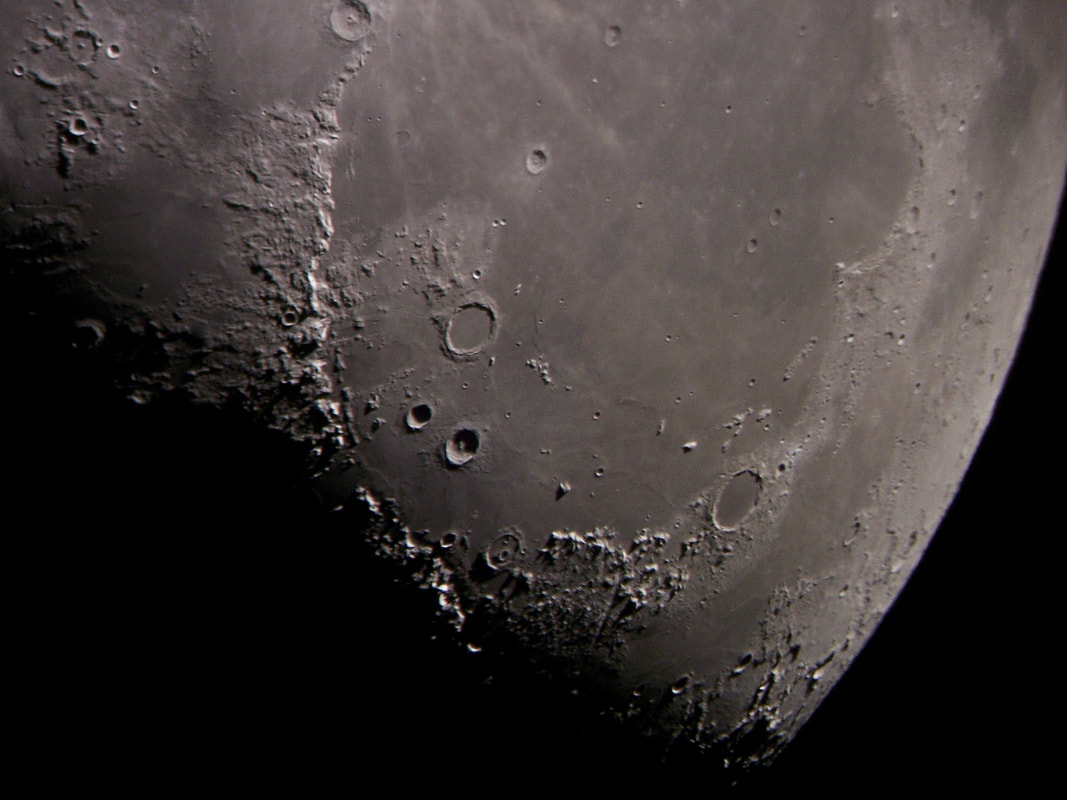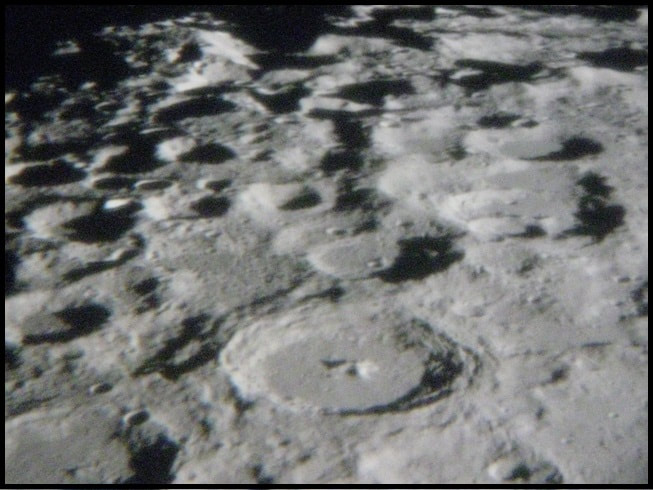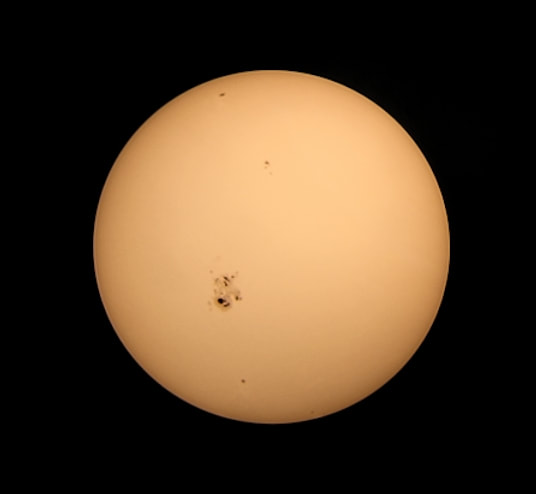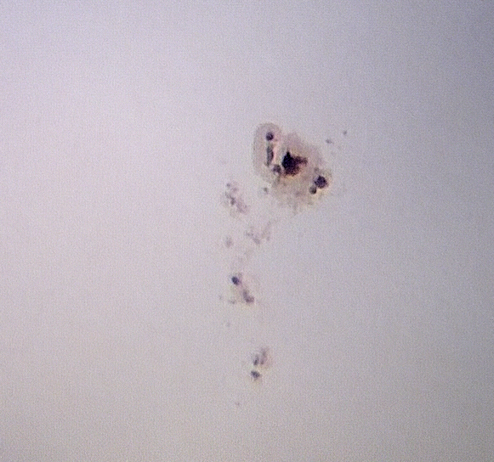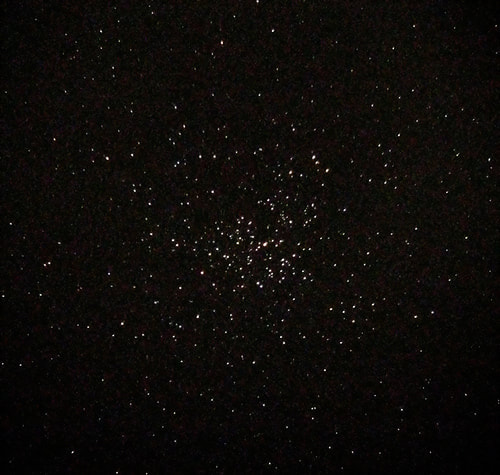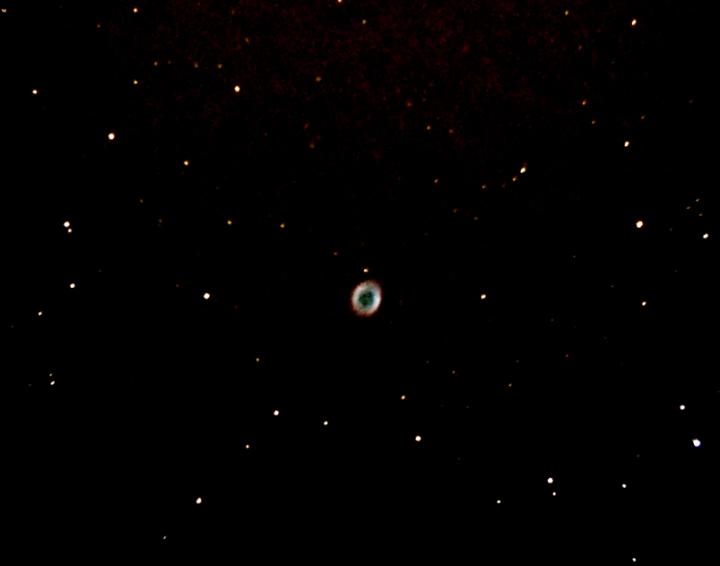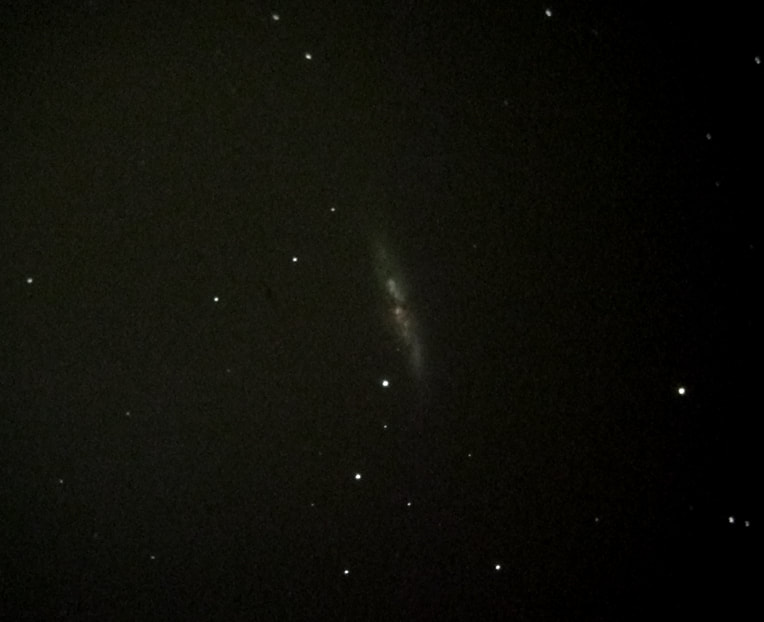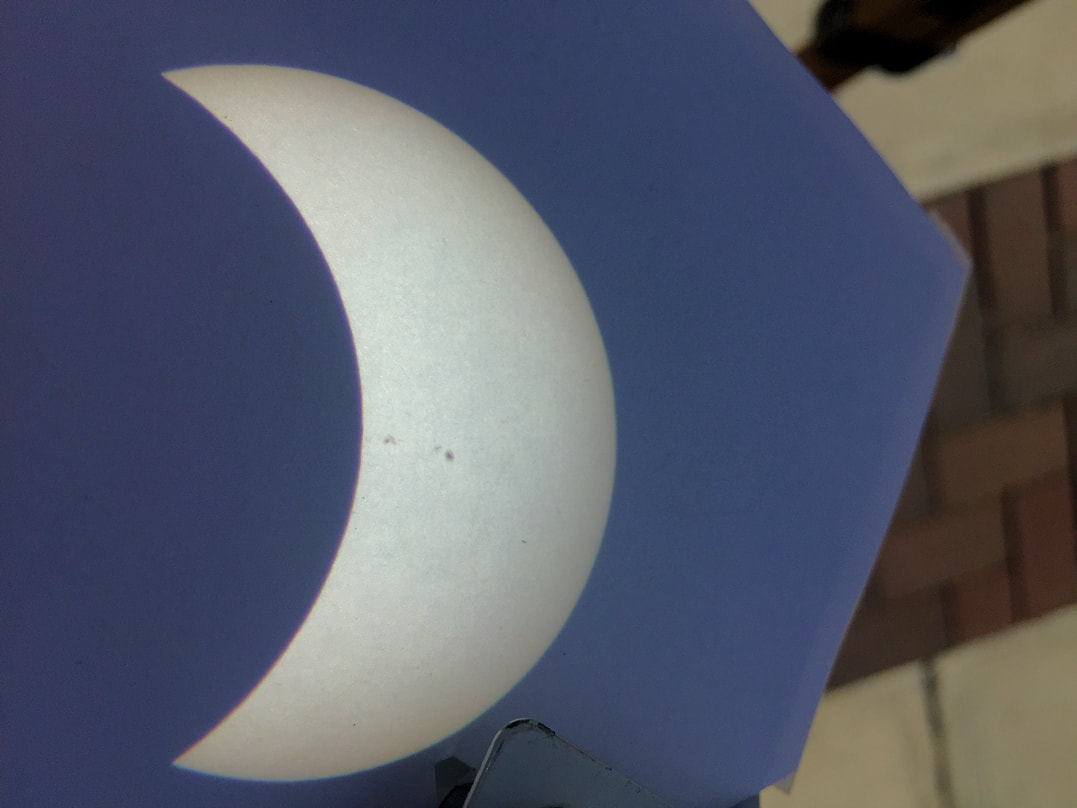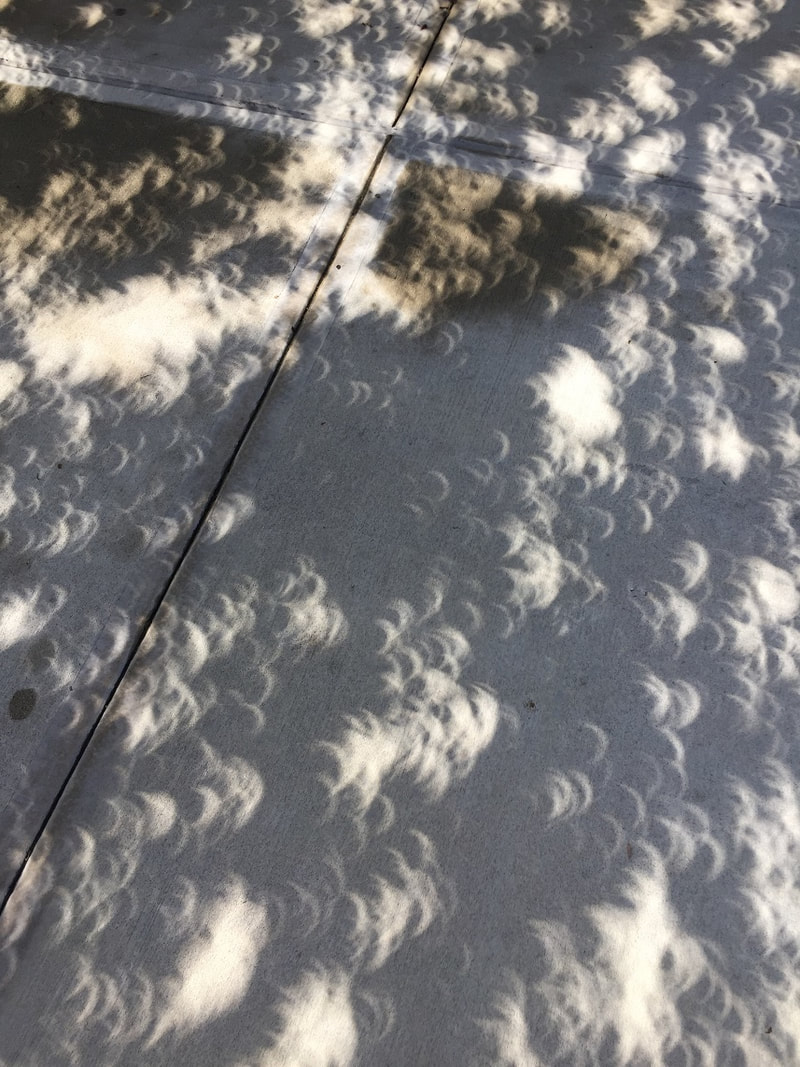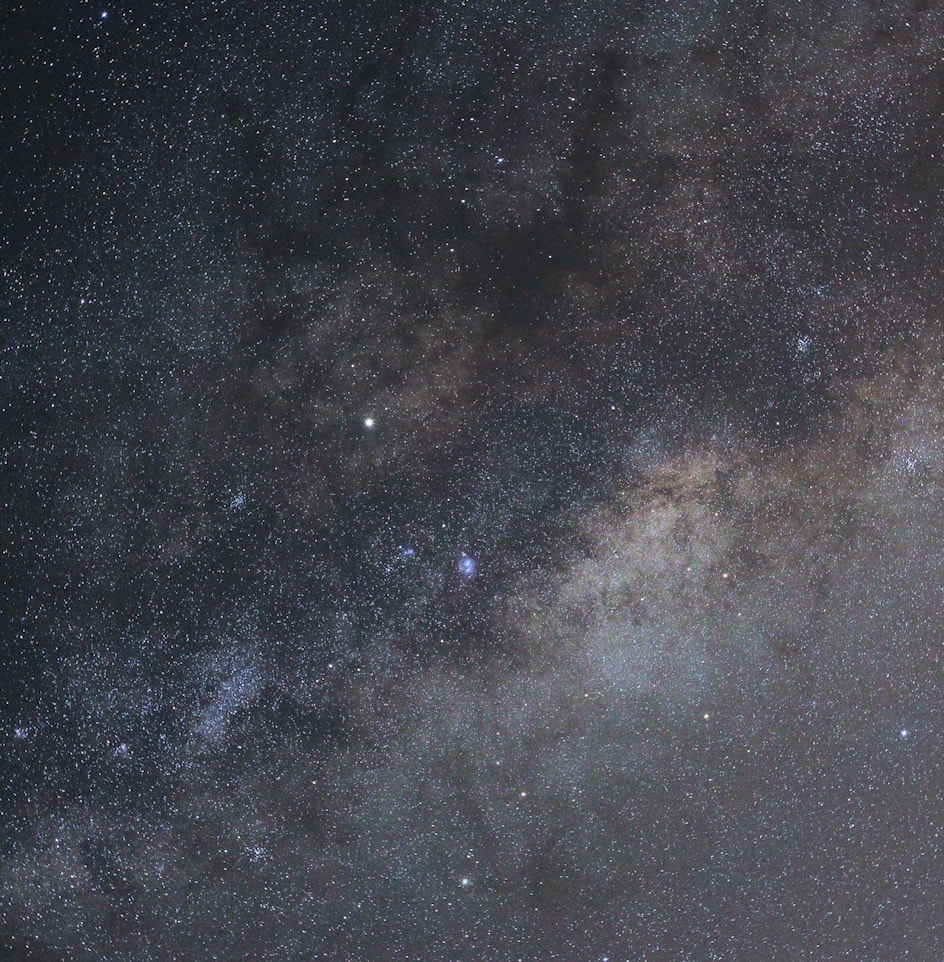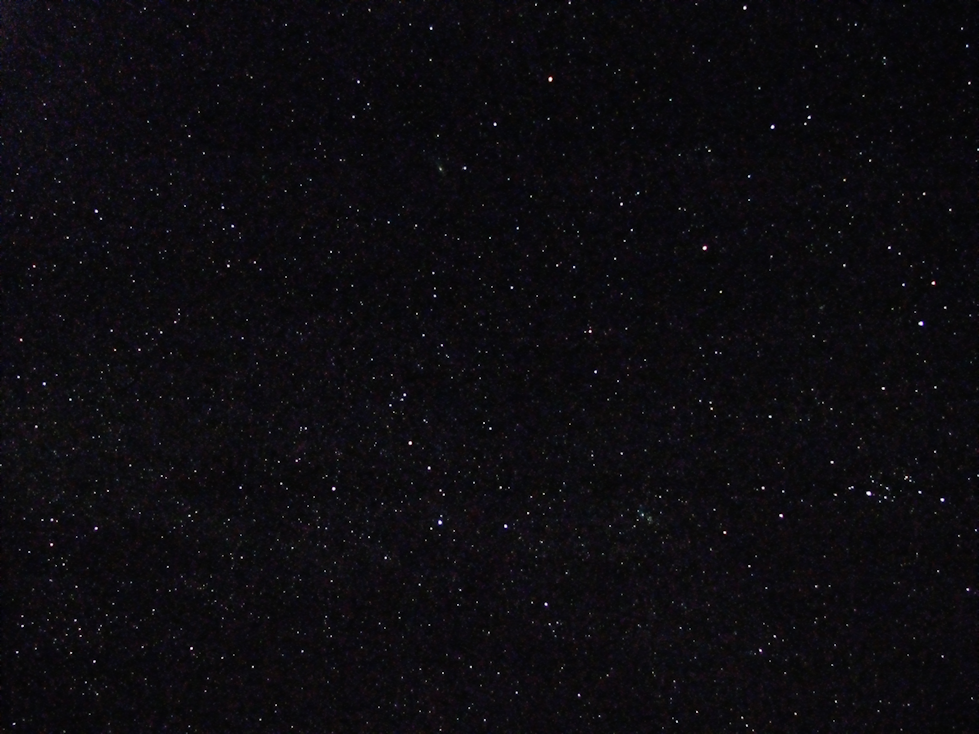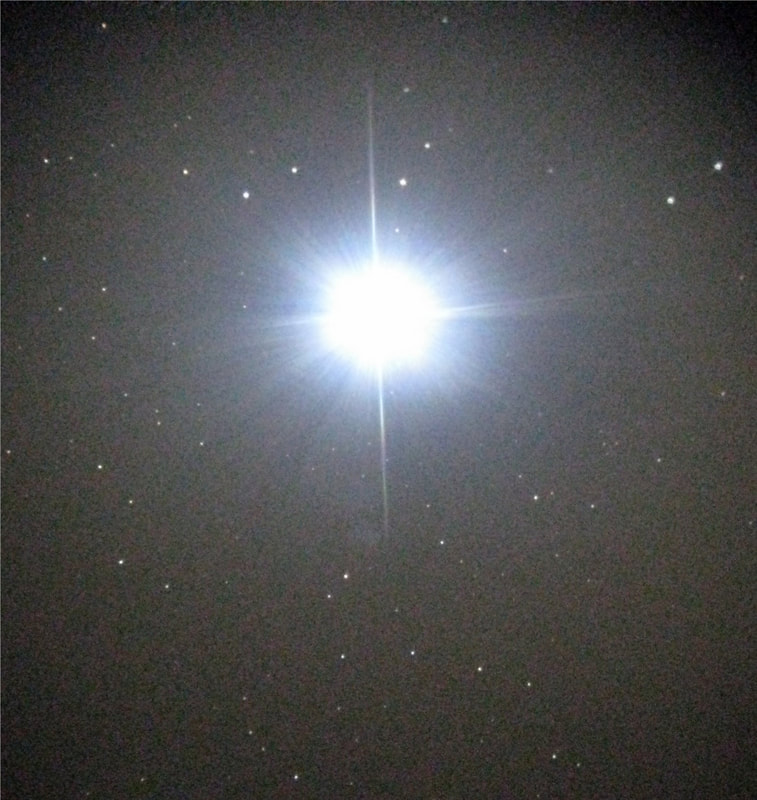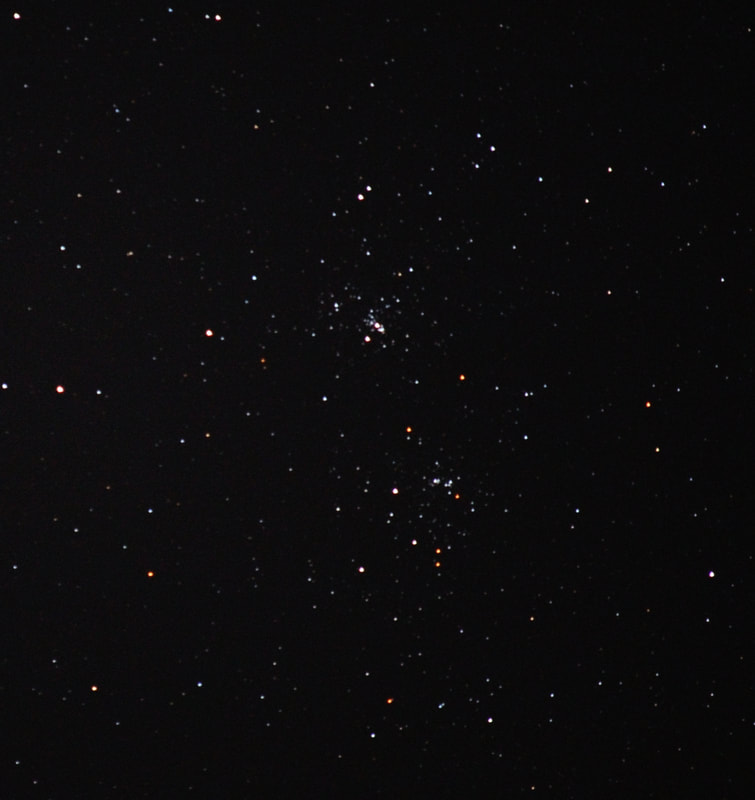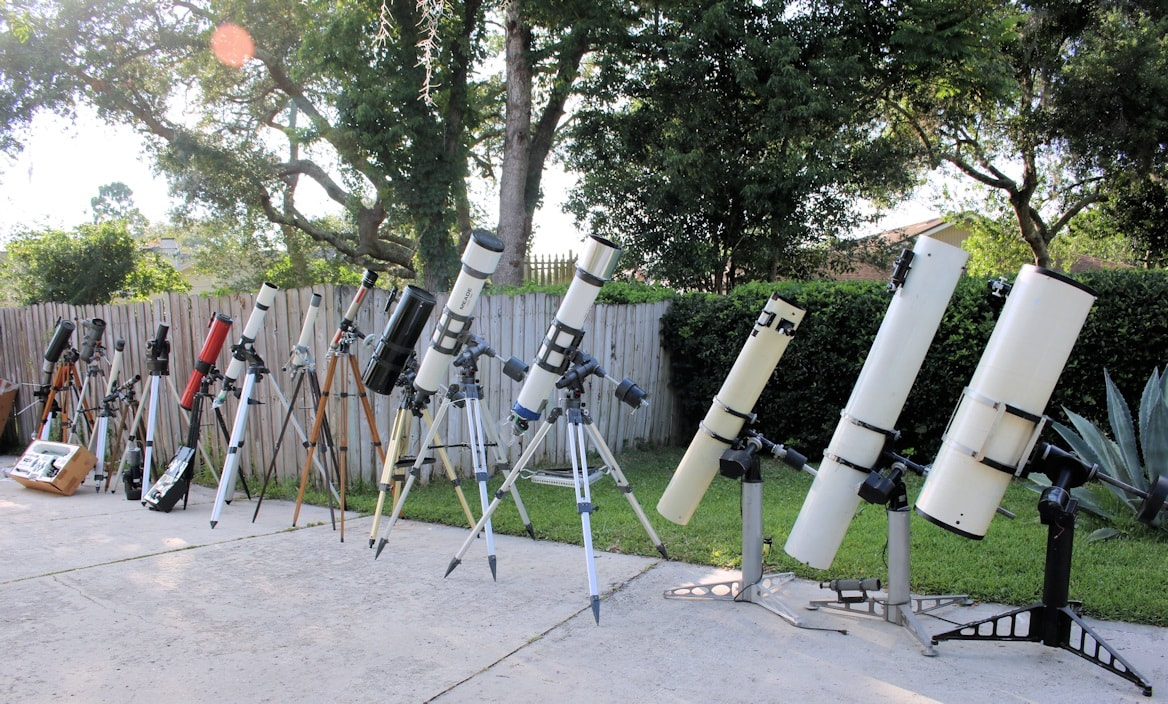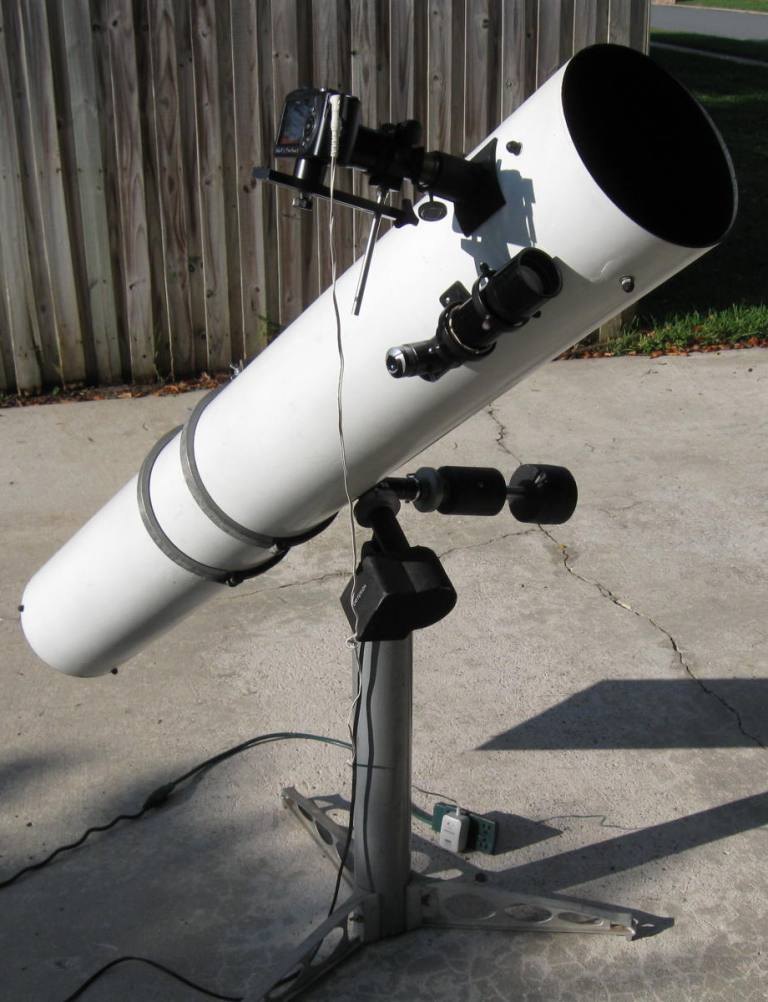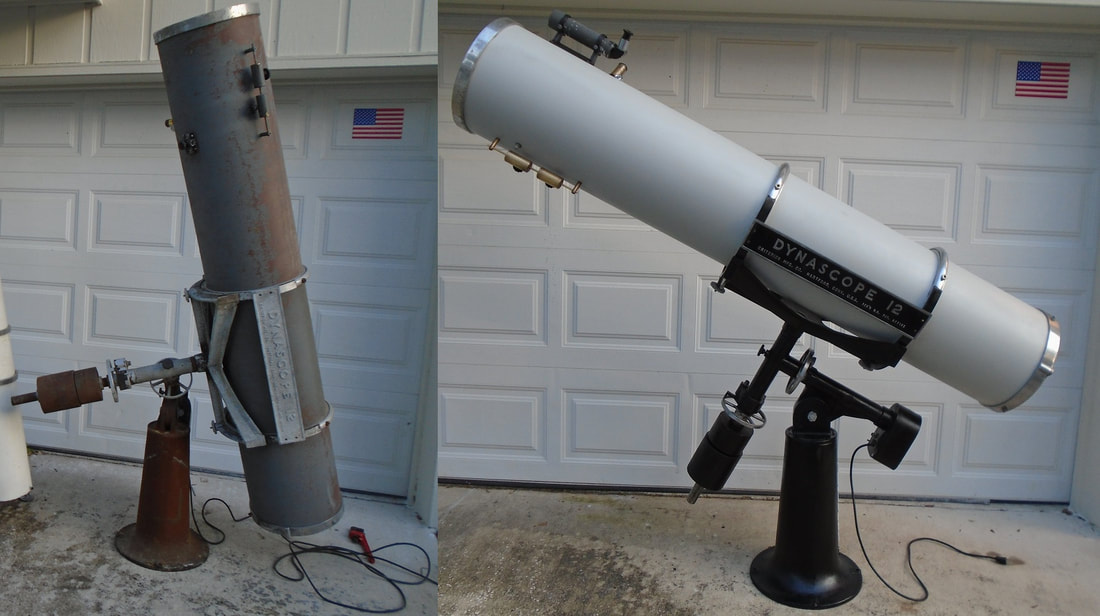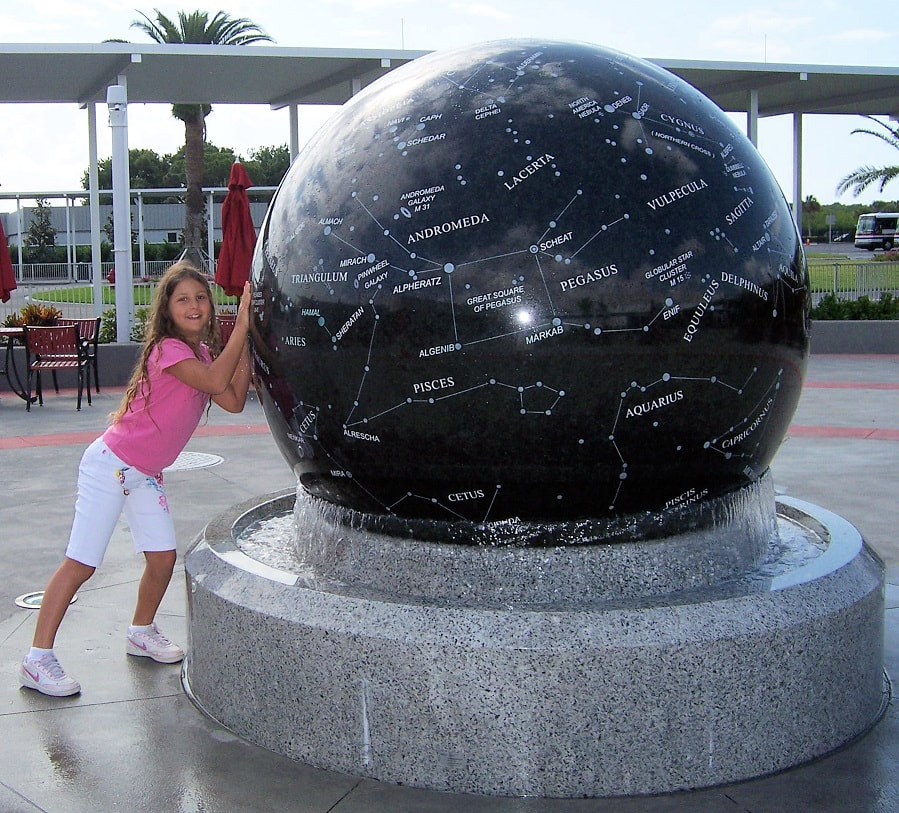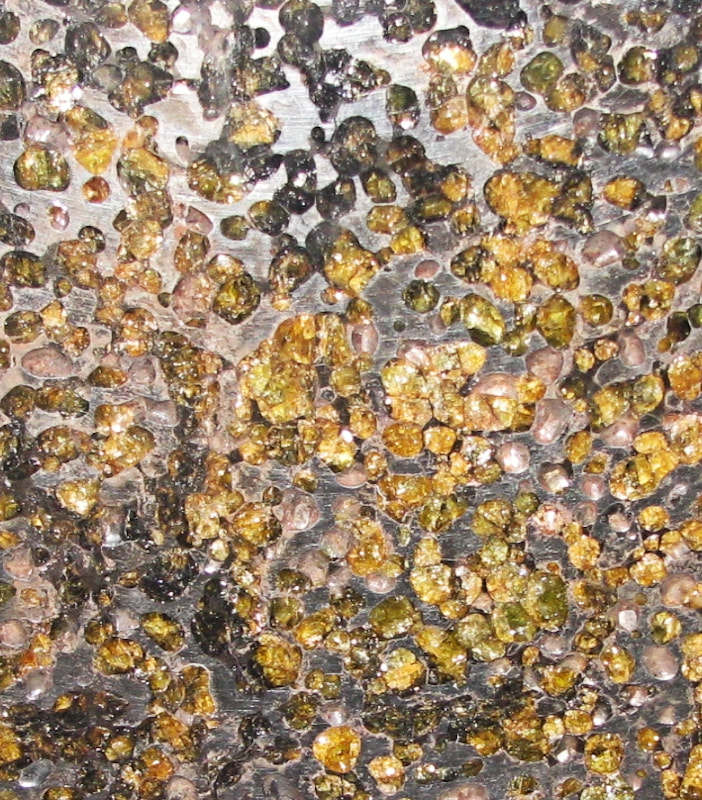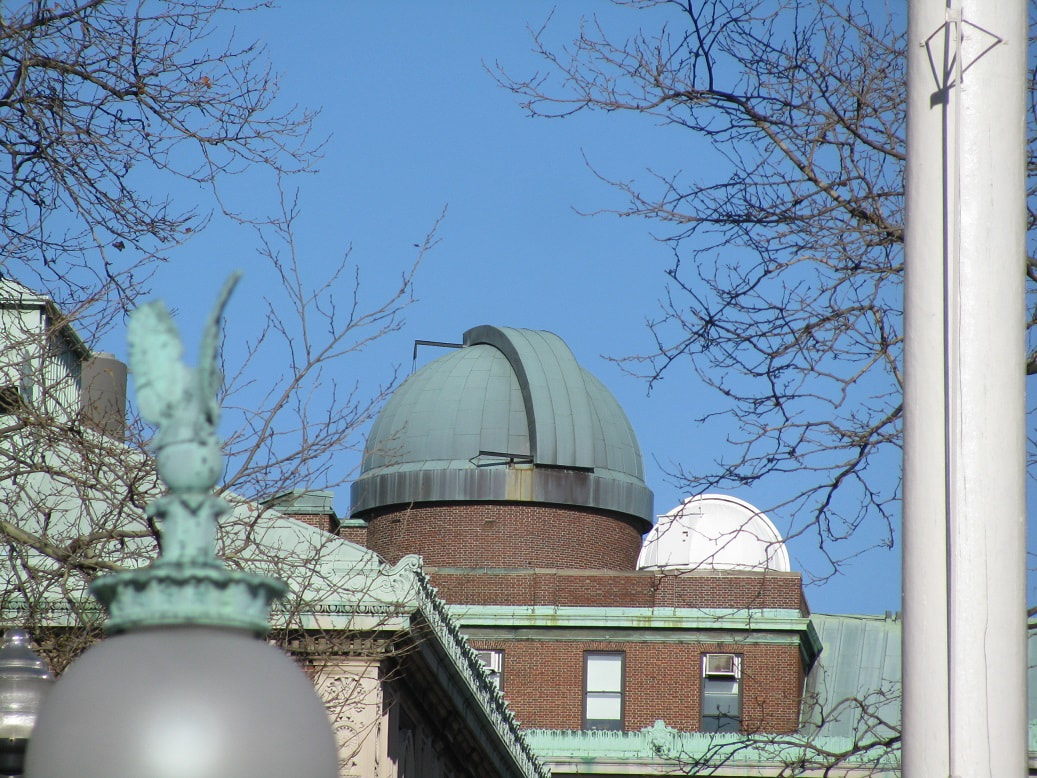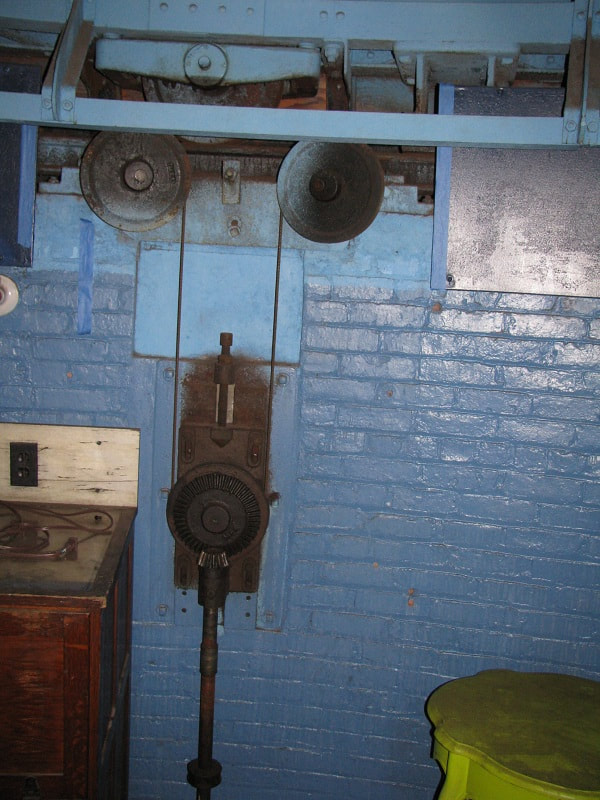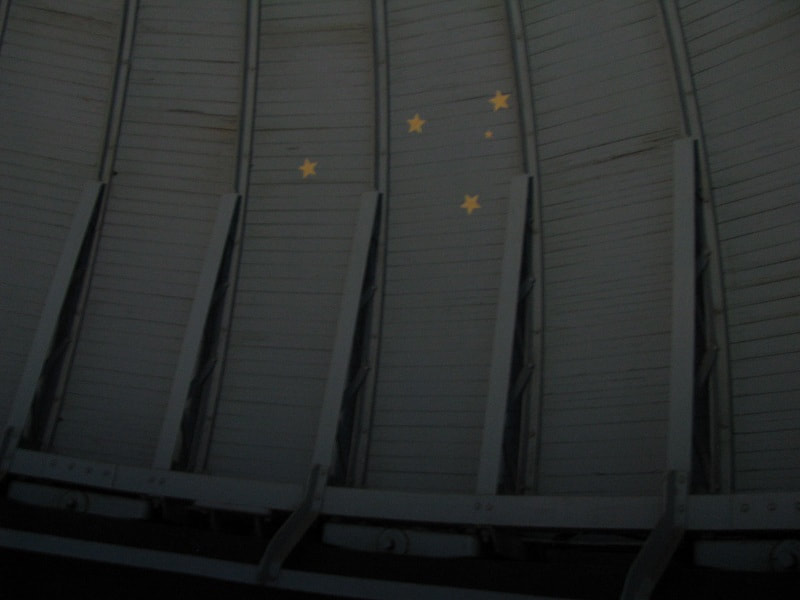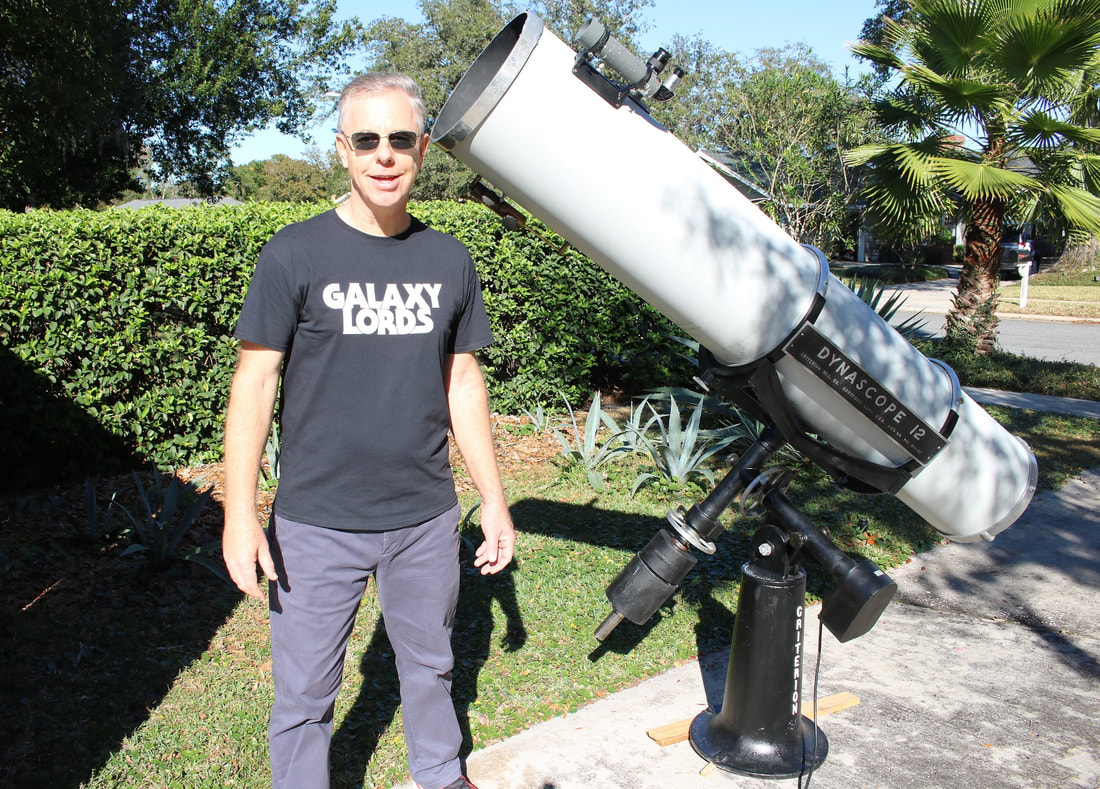Astro Images by Jason
First two images are the Ring Nebula M57 via SV-905c and Criterion Dynascope 12, 1 second frames, 101 frames live stack first one, second one 40 seconds. Shot June 1, 2024
Next two are Dumbell Nebula, 1 second frames, 42 second live stack, SV-905c camera, second image, second is a white-balanced version. Criterion Dynascope 12 used.
An open star cluster in Saggitarius, same camera and scope as above images.
M20 Trifid Nebula (I think :^) when I was pointing scope toward Saggitarius through the light pollution of Orlando. Same scope, camera and night shot as the above images.
The following image of the globular cluster M13 was shot on May 27, 2024 on a non-tracking mount using 33 seconds of Live Stacking in SharpCap software, via 12.5" Criterion Dynascope (scope made in the 1970's) with a SVBONY SV-905c camera (currently around $95 on ebay but full price $139 on amazon). No dark frames, flat frames etc., just a quick live stack. The sky transparency was forecast "below average" per Clear Sky Charts (and the sky was visually too.)
M8 Lagoon Nebula and the Hourglass Cluster, no tracking mount (but on a tripod), 116 one second exposures (using Live Stack in SharpCap), 30 mm telescope (SV165) using a SV905C camera, looking through the light dome of Orlando FL. Shot during a live stream on my Twitch channel, the AstronomyShow www.twitch.tv/astronomyshow on May 12, 2024
The image below is the globular cluster M3, shot during a live stream on Twitch in March 2024 and stacked from a portion the VOD (which has significant compression) by extracting the individual frames using the video editor in Blender, and using DeepSkyStacker for the stack, and GIMP for the post-processing. Telescope Criterion RV-6, using a $59 SV105 planet camera.
For comparision of the CO2 ice cap changing over time, this was Mars during the 2010 apparition, rotating, shot in a small scope using a point n shoot camera.
and by 2020 this was Mars (and Saturn and Jupiter with 2 of it moons shot on the same night) on 9-10 October, 2020 from Central Florida in a 6" newtonian telescope (a 1978 Criterion RV-6), using a SV105 camera and 2 stacked barlows.
A bunch of short live recorded video clips shot in the 6" telescope on Oct. 9-10, 2020 that the Mars and Saturn images above were based on .
A live stream I did on Earth Day 2021, through a Criterion RV-6 telescope using an inexpensive ($59.99) SVBONY SV105 camera.
Comet NEOWISE as shot from Longwood Florida on July 19, 2020 (by Jason Higley) using a Canon T6i camera on a tripod.
EXPERIMENTS WITH POINT-N-SHOOT CAMERAS
I used to do quite a bit of astro-imaging using common off-the-shelf point-n-shoot cameras years ago. I don't recommend using this approach these days because superior planet imaging cameras are much cheaper now, but the following images show the best efforts I could achieve using this primitive method. There are amateur astronomers who are much better than I am at this, you can find some of their images at https://www.cloudynights.com/forum/77-solar-system-imaging-processing/
I used to do quite a bit of astro-imaging using common off-the-shelf point-n-shoot cameras years ago. I don't recommend using this approach these days because superior planet imaging cameras are much cheaper now, but the following images show the best efforts I could achieve using this primitive method. There are amateur astronomers who are much better than I am at this, you can find some of their images at https://www.cloudynights.com/forum/77-solar-system-imaging-processing/
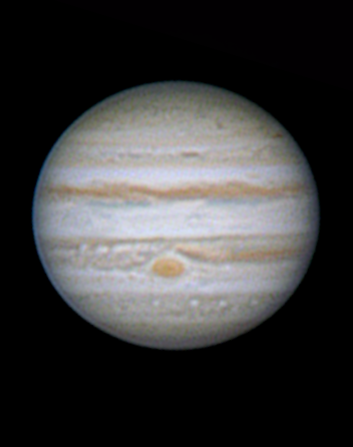
It took me a few years to eventually catch the Great Red Spot at the meridian in good weather. This shot is from December 2013 using a Canon Powershot point-n-shoot camera afocally mounted and zoomed at a 7mm TMB Super Planetary II eyepiece with a 2X Celestron Ultima Barlow lens (from Japan.) on a Criterion RV-8 (an 8" newtonian telescope made in the USA.)
Below ten years later, on Nov. 7, 2023 Jupiter through the same 8" Criterion RV-8 telescope but using a $59 SV-105 camera with the same 2x barlow.
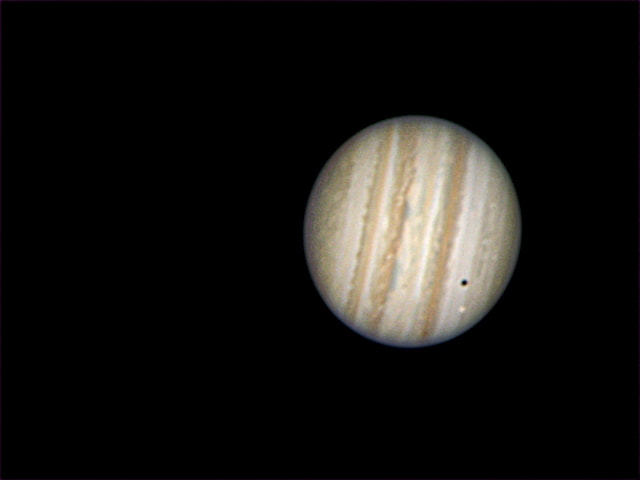
Jupiter and a transiting moon with its shadow, in the natural orientation relative to the viewer, using Criterion RV-8 telescope and Canon Powershot in video mode (frames stacked). I didn't rotate it here because I want to preserve the image, as regardless of what you might read elsewhere, rotating the image in software will cause some degree of degradation. I want to preserve the quality of this one because it's one of my best images color-quality-wise of Jupiter.
Here's a Jupiter video I shot using an afocally mounted Canon Powershot camera through an 8" newtonian telescope (a Criterion RV-8 made around 1970).
This is Saturn on Sept. 3, 2020 via a Sony Cybershot at the eyepiece of a Criterion Dynascope 12 that I'm restoring. The eyepiece was a 7mm TMB Planetary II. The video was stacked in Registax 6 and post-processed Corel Painshop Pro.
Here's a video I put together showing real images of our Milky Way a few years ago which were put together into a a single mosaic, an all sky image by ESO and S. Brunier. Panoramic animation of image and music by me.
This is a video in the Criterion RV-8 using a very cheap Insignia NS-DV720p consumer camera bought years ago on closeout from BestBuy (the camera doesn't even have optical zoom.) Shot afocally through an eyepiece and in the 2nd video a 2x barlow too.
During the August 21st 2017 solar eclipse Earth-sized sunspots were visible, I was using the projection method here via a stopped down 60mm Tasco (yes I said the T-word) telescope and 17 mm Televue eyepiece cooking in the path. My wife used her i-Phone to snap this shot. Yes that's rust on the projection plate (but I used new card stock for the projection screen.)
The tree leaf projections of the eclipse were visible in this shot at Altamonte Springs Crane's Roost Park. Photo by my 12 y.o. son.
We reached just over 85% obscuration during the solar eclipse at Altamonte Springs Crane's Roost Park. That's the primitive setup I used (but it worked better than I could hope for) which shows the projected image of the Moon and Sun the children are looking at. The telescope's objective lens was further obstructed/stopped-down to limit the amount of light coming in.
This image is a montage of my best astro images up to 2014.
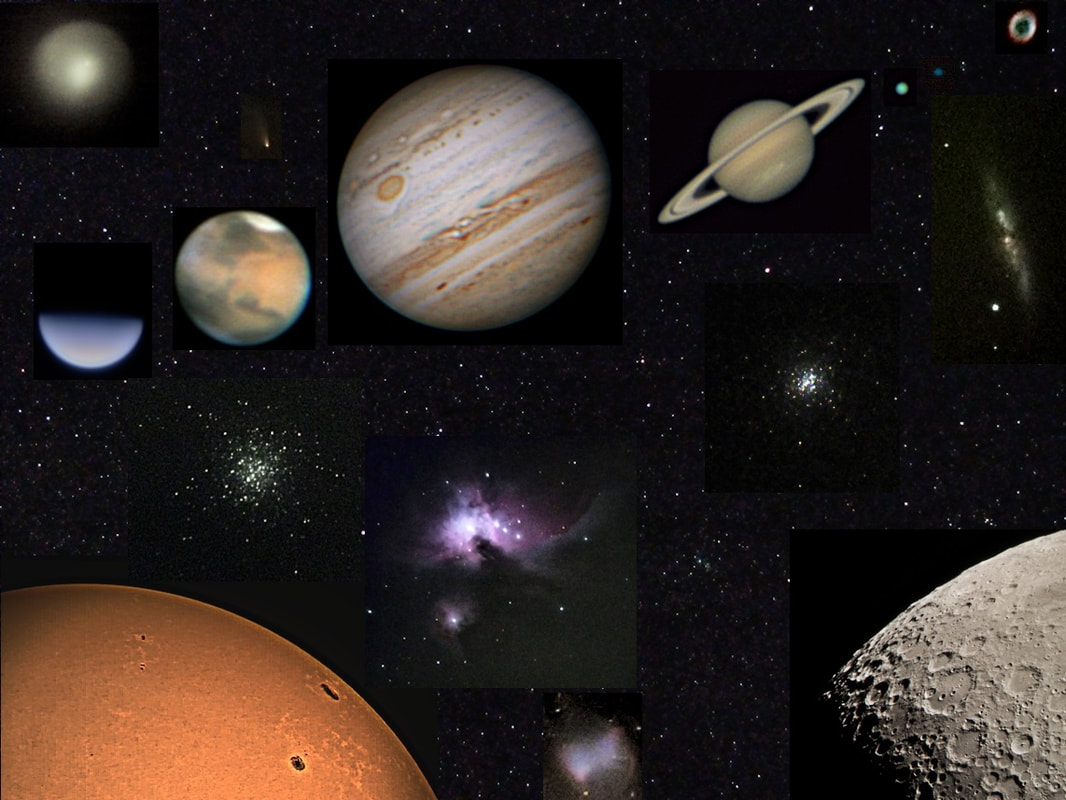
The planet images were via afocally mounted point-n-shoot camera stacked videos, the Moon was a single exposure. All with point-n-shoot cameras, with most (except for the smaller comet and the overall background stars) mounted at the eyepiece on a 6" and 8" Criterion telescope (a now-defunct American manufacture. I was determined to make afocal point-n-shoots work for the common man back when cameras were expensive and the point'n-shoot camera sensors and video compression format (.avi) was more useful for planet imaging. Nowadays the h.264 and other compression formats are not as useful (bad artifacts when stacked), so I've stopped doing this type of acquisition until things get better again. Nowadays I'm experimenting with other not-so-usual methods of imaging, and new breakthroughs (by others) promise to open up whole new ways of imaging, and I hope to post some interesting results this Fall.
The image below of the Milky Way was acquired with the generous help of one of, in my opinion, the best astro-imagers out there, just South of Yeehaw Junction Florida, in late March of 2017. He generously loaned me his mount (which he also operated) and excellent lens and basically did everything possible to make this a good run and experience for me (so basically it's because of his efforts that it was accomplished.) I don't list his name because I don't want to ruin his good reputation because of my relatively un-expert image processing, but I greatly appreciate his help and valuable insights. I used my Canon T6i and it's a single exposure of 98 seconds (I tried some stacks, but in this case the single exposure looked much cleaner.) Post-processing was by me, and I had to crop it a bit and deal with the LP gradient too (as it was still Spring, low to the horizon just before sunrise.)
Looking toward Cassiopeia, below is a stack of 4 frames from a point n shoot camera, Canon SX100.
The ridiculously bright star below is Sirius, the brightest star visible to the eye. There is vignetting, but I didn't crop the vignetting or process the noise so as to preserve the awesomely serious Sirius. :^) Have you ever seen a brighter white on any screen?
The Double Cluster - the image below was created using a Canon T6i camera only (no telescope or tracking mount) on a stationary camera tripod), aperture set to f/5.6, it's a stack of 10 two-second exposures, using the stock 55-250mm lens (from Costco :^) with the focal length being the fully extended 250 mm. The reason you can get away with 2 second exposures here without significant star trailing is because of how far North the Double Cluster is (stars in closer proximity to Polaris [AKA The North Star], appear to move less rapidly here than those South of here.)
Some of my telescopes in the driveway as of May 2019
Below is a Criterion RV-8 telescope, an 8" newtonian telescope from around 1970 by an American company, with a point-n-shoot camera on it showing how I used to image planets and other things.
Before and after images of the Criterion Dynascope 12 I'm restoring, a 50 year old 12.5" newtonian telescope made in the U.S.A..
This spinning floating celestial sphere image with my middle kid was at Kennedy Space Center.
This is a slice of the Brenham Pallasite Meteorite, I shot this at the American Museum of Natural History in New York.
Here's a close-up of the jewel-like Brenham Pallasite Meteorite.
Some might find it hard to imagine, but there is an observatory in New York City's Manhattan! It's at Columbia University's Rutherford Observatory. I visited there and spoke with an Astronomer who operates it. Fascinating history. It's inspiring that they can work in such severe light pollution. The green dome is made of copper.
Inside Columbia University's Rutherford Observatory Dome in upper Manhattan, NYC. It might seem a bit of overkill for such a modest scope, but that's because the original larger one was removed to a different location many years ago.
This heavy dome rides on a railroad track!
The ironwork supporting the dome.
I'll post other images here in the future.
If you should ever happen to have questions about how to get into amateur Astronomy, how to use a telescope, or about anything related to Astronomy, feel free to contact me at reachjasonh@ (and add gmail.com to the end of that) and hopefully I can either provide you with, or steer you to, the info you are seeking.
If you should ever happen to have questions about how to get into amateur Astronomy, how to use a telescope, or about anything related to Astronomy, feel free to contact me at reachjasonh@ (and add gmail.com to the end of that) and hopefully I can either provide you with, or steer you to, the info you are seeking.
THE TRANSIENT BLUE LIGHT ON THE MOON - When looking at Earthshine on the Moon on just the first few days immediately after New Moon, look for the Blue Light in the Moon's dark-side area with a telescope for a point source of soft blue light. It was a mysterious phenomena reported for hundreds of years by professional and amateur astronomers alike (see the NASA report on this Technical Report R-277 Chronological Catalog of Reported Lunar Events, published in 1968 https://ntrs.nasa.gov/citations/19680018720 ). I reached closure on what it was when I used a 20" telescope to see what the point source like blue light was on the Moon, it is reflected Earthshine from Aristarchus crater (Aristarchus region as the source of a transient blue light on the Moon was mentioned many times in the 1968 NASA report), specifically it comes from the bright walls of the crater.
If one uses 3D software to place a viewing perspective from Aristarchus crater toward Earth, immediately after New Moon, the side of the Earth presented to the Moon at that time shows that the reflected light from Earth is predominately from the Pacific Ocean, and the oceans are the bluest aspect of the Earth (see Earth images from space), so the Aristarchus crater point source blue reflected light is that of Earth's oceans (which absorb all other colors and reflect blue light), which is the reflected light from the nearest star, our Sun, so the light is ~2.5 seconds older than the other light landing on (other parts of the) Earth at that time you see it. BTW, at this time from Aristarchus, Earth looks almost Full and large in the sky, Full Earth = bright (especially when compared to a Full Moon.) Imagine seeing that with your own eyes while standing in a blue-walled crater!
If one uses 3D software to place a viewing perspective from Aristarchus crater toward Earth, immediately after New Moon, the side of the Earth presented to the Moon at that time shows that the reflected light from Earth is predominately from the Pacific Ocean, and the oceans are the bluest aspect of the Earth (see Earth images from space), so the Aristarchus crater point source blue reflected light is that of Earth's oceans (which absorb all other colors and reflect blue light), which is the reflected light from the nearest star, our Sun, so the light is ~2.5 seconds older than the other light landing on (other parts of the) Earth at that time you see it. BTW, at this time from Aristarchus, Earth looks almost Full and large in the sky, Full Earth = bright (especially when compared to a Full Moon.) Imagine seeing that with your own eyes while standing in a blue-walled crater!
One other thing, fhe scale of the Universe often comes up during public telescope outreach events I attend, and guess what, WE DON'T KNOW HOW BIG THE UNIVERSE IS! Although the Universe is ~13.79 billion years old, the "visible Universe" is currently estimated to be 93 billion light years wide in diameter, and it is theoretically possible to see objects that are up to 46.5 billion light-years away! (because we are at the center, or the middle, of our 93 billion light year viewing bubble). However there are parts of the Universe that are so far away from us that they are forever beyond our detection, due in part to their traveling away from us faster than the speed of light! (because of the Universe's ever accelerating expansion; strangely enough this does not break the "nothing can go faster than the speed of light" rules; you can read more about that here.)
Even more mind-blowing to me, everything we see, all of the stars, planets (more planets in the Universe than all of the grains of sand on the beaches and deserts of Earth), and the gas/dust clouds we see are only 6% of ordinary (baryonic) matter, or about 0.3% of what makes up the Universe.
Lucky for us we will never run out of things to discover and observe in this amazing Universe, and there are so many ways to approach and have fun in this hobby (and science) of Astronomy; what's better than that?
Clear skies and good seeing! Jason Higley
Even more mind-blowing to me, everything we see, all of the stars, planets (more planets in the Universe than all of the grains of sand on the beaches and deserts of Earth), and the gas/dust clouds we see are only 6% of ordinary (baryonic) matter, or about 0.3% of what makes up the Universe.
Lucky for us we will never run out of things to discover and observe in this amazing Universe, and there are so many ways to approach and have fun in this hobby (and science) of Astronomy; what's better than that?
Clear skies and good seeing! Jason Higley
